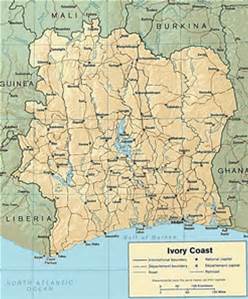The Ivory Coast was a colony of France. The country official name is Cote d'Ivoire. It is one of the most prosperous West Africa countries.
The landscape copies Ghana with rain forest in the south and high grassy plains in the north.
The hot, steamy south was covered with forest but it was cut down to make way for coffee and cocoa plantations.
Many wild animals live on the northern plateau such as lions, monkeys, antelopes and elephants. There is also grazing for cattle.
Two-thirds of the people living there are growing food like maize, rice and jams. Crops for export are grown and Ivory Coast is one of the world's largest coffee and cocoa producers.
Industry
Younger generation are working in factories in the old capital and chief port, Aidjan. Half of the population is under 20 years old. Flour mills food canneries, breweries, sawmills, textile and plastics manufacturers are all thriving.
Since 1980 there is a prosperity boost from an offshore oil extracted from the Gulf of Guinea.
History
From 1893 to 1960 the French ruled the country. It became independent under the presidency of Felix Houphouet-Boigny. He remained till his death in December 1993.
His policies were - keep close ties with France; allowing plenty of foreign investment and keeping tribal rivalries under control.
 |
| ABIDJAN |
One of his major acts were to move the capital from Abidjan, known as the Paris of Africa, to his home village of Yamoussoukro.
 |
| YAMOUSSOUKRO CITY |
The Ivory Coast republic has a population of 13 million and an area of 322,463 sq km. The religion is Muslim, Christian and Traditional.
 |
| BASILICA OF OUR LADY OF PEACE |
A Basilica of Our Lady of Peace was built in the capital and it is the biggest church in the world. It is modelled on St Peter in Rome and completed in 1989.


No comments:
Post a Comment